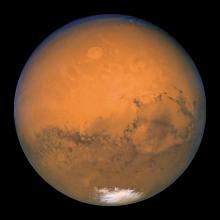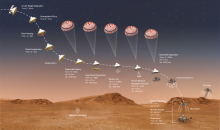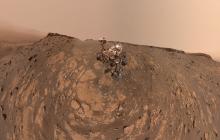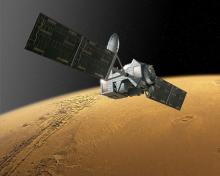You are here
Mars

Scientists, too, have speculated about the possibility of life on Mars. During the 1800s, some leading astronomers thought that an advanced civilization inhabited the planet -- a civilization that built vast "canals" to sustain a dying world. But investigations with increasingly sophisticated ground-based telescopes, followed by the Mariner and Viking missions of the 1960s and '70s, crushed the dreams of grand Martian cities. Mars is too cold and too dry, and its air is too thin, to sustain large organisms.
The farthest of the terrestrial planets from the Sun, Mars orbits between Earth and the asteroid belt. It takes Mars almost twice as long as Earth to orbit the Sun, but a day on Mars lasts almost exactly as long as a day on Earth -- slightly more than 24 hours.
Mars is only about half as big as Earth, but it is enveloped by a thin, cold atmosphere of carbon dioxide and traces of other gases. Temperatures seldom climb to the freezing mark, and can plummet below –200 degrees Fahrenheit (–120 C).
The planet's surface is red because iron in its soil long ago reacted with the tiny amount of oxygen left on Mars to produce rust. Dry riverbeds criss-cross the surface, and several giant volcanoes rise high into the Martian sky. The largest, Olympus Mons, towers 17 miles (27 km) high and covers an area as big as the state of Missouri. Mars also boasts a giant network of valleys that would stretch from New York to Los Angeles. Known as Valles Marineris, it dwarfs the Grand Canyon.
Ice caps cover the Martian poles. When sunlight warms the polar ice caps, water and carbon dioxide vaporize and rush into the air, stirring up tiny grains of dust. The Martian winds carry them around the planet, picking up even more dust. That stirs up dust storms that can last for days or weeks and cover almost all of the planet's surface.
Conditions on Mars don't rule out the possibility of microscopic life. Frozen or even liquid water may exist beneath the Martian soil, perhaps providing a home for living organisms. The Viking landers looked for evidence of such organisms, but their experiments were inconclusive.
The fleet of spacecraft now at Mars — and more heading out in the coming years — will try to sniff out signs of life. And scientists are studying meteorites from Mars — chunks of Martian rock here on Earth — for signs of ancient Martian life. Scientists continue to debate the results as they continue the long quest to find life on Mars.
Is there life on Mars?
The possibility of life on Mars has intrigued skywatchers throughout the ages, but not until 1996 was the belief in Martians anything more than hopeful speculation. On August 6, 1996, a team of NASA scientists announced that they had evidence, which, though inconclusive, compelled them to believe that life had once existed on Mars. The evidence consisted of samples from a Martian meteorite -- named ALH84001 -- containing various organic chemicals and what appear to be clumps of "microfossils," similar to microscopic fossil bacteria found on Earth.
Most other scientists disagree that the meteorite shows evidence of life. Their tests indicate that most of the "evidence" was created by basic physical or chemical processes. But the original team remains convinced, and even says it's found evidence of life in other meteorites from Mars.
The study of the Martian surface and the search for possible life existing there — past or present — remains a high priority for the world's space programs. As of the middle of 2021, a dozen spacecraft are operating at Mars: the Curiosity, Perseverance, and Zhurong rovers plus the stationary InSight lander on the surface, and Mars Odyssey, Mars Reconnaissance Orbiter, Mars Express, Maven, Mars Orbiter Mission, Trace Gas Orbiter, Hope, and Tianwen-1 in orbit. With luck and hard work, this question may soon have a definitive answer.
Viewing Guide
♂Mars can vary considerably in brightness, and 2023 is an "off" year for the Red Planet. Getting progressively dimmer, our fourth planet from the Sun will vanish into the sunset in early October and not come back into view again until the second week of January 2024.
Exploration
Building on the success of the 1997 Sojourner rover, the Spirit and Opportunity rovers landed on Mars in 2003. Although their planned mission was just 90 Mars days long (about 92 Earth days), Spirit continued operating until March 2010, while Opportunity was still going strong heading into 2015. Both found evidence that water had helped shape the Martian landscape in the distant past. Several American and European craft found similar evidence from Mars orbit. The Curiosity rover landed in 2012. It, too, has found evidence of standing water in the planet's distant past, as well as traces of methane, a gas that can have a biological origin, in the Martian atmosphere. Ditto for Perseverance, which landed in Jezero Crater in early 2021.
Keywords
At a Glance
| Discovery Known since antiquity |
| Name Roman god of war |
| Average Distance from Sun 141,633,260 miles 227,936,640 km 1.524 Astronomical Units |
| Equatorial Diameter 4,222 miles 6,794 km |
| Mass 0.107 times Earth's mass |
| Length of Day 24 hours, 39 minutes, 35 seconds |
| Length of Year 1.88 Earth years 686.9 Earth days |
| Surface Gravity 0.38 that of Earth (If you weigh 100 pounds, you would weigh about 38 pounds on Mars.) |
| Known Moons 2 (Phobos and Deimos) |
Teacher Copies
Request a free copy of The Solar System or Beyond the Solar System for your classroom. Bulk copies are available for $1.50 each in quantities of 30 or more. Shipping is included. Call 512-471-5285 for orders of 30 or more.
 The Astro Guides for the Solar System and Beyond the Solar System are supported by the National Aeronautics and Space Administration under Grant Nos. NNG04G131G and NAG5-13147, respectively.
The Astro Guides for the Solar System and Beyond the Solar System are supported by the National Aeronautics and Space Administration under Grant Nos. NNG04G131G and NAG5-13147, respectively.






